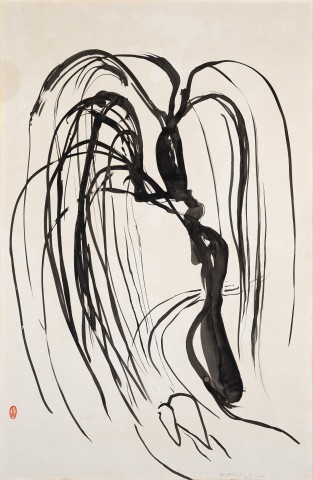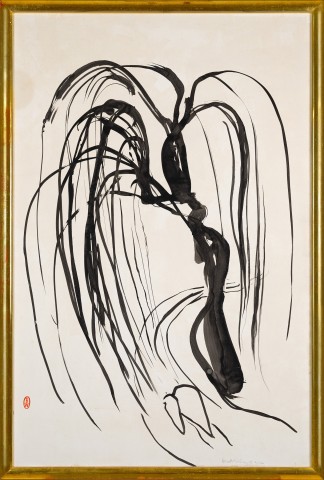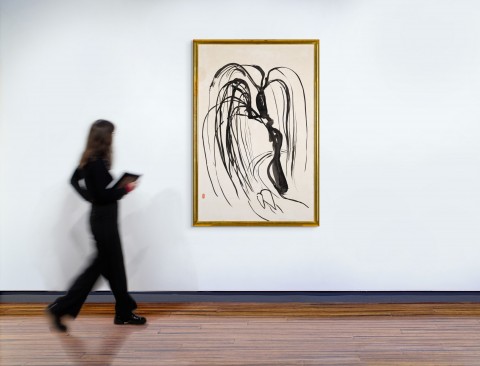THE WILLOW, 1979
BRETT WHITELEY
brush and ink on paper on composition board
153.5 x 101.0 cm
signed, dated and inscribed with title lower right: brett whiteley 79 'the willow'
stamped lower left with artist's monogram
bears inscription verso: 27
original Brett Lichtenstein frame, Sydney
Robin Gibson Gallery, Sydney
Private collection, Sydney
Thence by descent
Private collection, Sydney, acquired from the above in 2009
Brett Whiteley: Portraits: Crucifixions: (a paddock at) Oberon, David Reid’s Gallery (by Robin Gibson),
Sydney, 26 April – 17 May 1980, cat. 27 (as 'The Willow, 1890' [sic], illus. in exhibition catalogue)
Sutherland, K., Brett Whiteley: Catalogue Raisonné, Schwartz Publishing, Melbourne, 2020, cat. 153.80, vol. 7,
p. 520 (dated 1980)
Drawing was the cornerstone of Brett Whiteley’s artistic practice, and his diverse works on paper informed and supported the major paintings and sculptures produced throughout his lifetime, often exploring alternate compositional emphases with fluid mastery of each of his chosen mediums. The Willow, 1979 depicting a weeping willow tree bent over a river bend with semi-submerged boulders, is entirely composed of sinuous lines of black ink, placed on a fresh sheet of paper with expressive and confident immediacy. The effect is striking in its sparse and graphic simplicity. In paring back his subject matter, Whiteley makes his recurrent motifs of a meandering river and a statuesque tree into synecdoches - the isolated elements of his beloved pastoral landscapes becoming shorthand symbols of the larger restorative natural forces of this countryside.1
The late 1970s were decidedly tumultuous years in the lives of Brett and Wendy Whiteley, peppered with astounding highs such as the artist’s winning of both the Wynne and Sulman prizes in 1977, and then of all three, the Archibald, Wynne and Sulman the following year, counterbalanced by periods of extreme dependence on narcotics and restorative sojourns in the Central Tablelands of west New South Wales. The landscape was a conceptual and real escape from the realities of daily existence and the equally clamorous pressures of Whiteley’s successes and vices. Products of the artist’s joyful communion with the natural world, the most beautiful and lyrical landscapes of Whiteley’s career were created during these trips. Indeed, in addition to featuring alone in many works on paper, the (often golden yellow) riverside willow appears in many larger and acclaimed painted compositions of this time and later throughout the 1980s, including Alchemy, 1972 – 73; River at Carcoar, 1977; Summer at Carcoar, 1977; The Wren, 1978 and Autumn (Near Bathurst), 1987 – 88.
Returning to a region familiar from his childhood stirred feelings of tenderness in the artist, which in turn imbued certain pastoral compositions with a hint of magical realism and whimsical naiveté, aesthetically removed from his brash meditations on city living. Whiteley’s introspective focus was informed by his admiration for Zen Buddhist philosophy and the meditative process of brush-and-ink calligraphy borrowed from Asian art. Whiteley described Zen as the ‘theology of drawing’2 and viewed this ancient medium as ‘the great unalterable’3, its application requiring the utmost confidence and mindfulness. The resulting works on paper bear a spontaneous and fluid quality, lyrically balancing deep black inks with the negative space of the unaltered paper sheet. Whiteley’s characteristic freehand brushstrokes describe the interlocking curves of a short segment of this meandering river and the willow’s knotted trunk, its fronds gracefully trailing over the water and radiating from the centre of the composition like a suspended firework. In just a few lines, with great agility, Whiteley has captured and preserved a moment in time, suspending in stillness the gently swaying branches of the tree and the current of the river as it is gently diverted around the rocks.
1. The same could be said for the recurrent motifs of Palm and Jacaranda trees, and various birds.
2. McGrath, S., Brett Whiteley, Bay Books, Sydney, 1979, p. 168
3. Drawing and How to Get it On, 1975, illus. in McGrath, ibid., p. 183
LUCIE REEVES-SMITH


